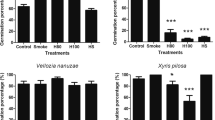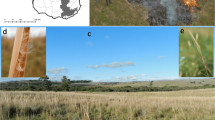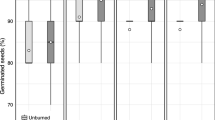Abstract
Fire is an important ecological factor shaping plant strategies. Plants that are not able to survive fire and rely on seed reproduction may have seeds adapted for surviving heat shock or their germination may even be enhanced by heat or smoke. In order to find out whether such adaptations may be found in plants able to survive fire and resprout, we examined the germination of ten Vellozia species in response to heat shock and smoke. Seeds were collected in two community types differing in fire frequency: campos sujos (open savannas with frequent and hotter fires) and campos rupestres (montane grasslands on rocky outcrops, with less frequent and milder fires). We hypothesized that seeds of plants inhabiting campos sujos would be more tolerant to fire or will even be stimulated by heat shock or smoke in comparison with seeds of plants inhabiting campos rupestres. We confirmed our expectations only partly, as (i) seeds of all species survived heat shocks of 60 and 100°C for one minute and seeds of three species survived the temperature of 200°C, (ii) the smoke treatments increased germination by 20–40% in three species from both communities, and (iii) mortality after the hottest heat shock was greater in seeds of plants from campos rupestres than from campos sujos. Fire- and smoke-related germination strategies help populations of Vellozia species to cope with recurrent fires in fire-prone ecosystems.



Similar content being viewed by others
References
Alves R (1994) Morphological age determination and longevity in some Vellozia populations in Brazil. Folia Geobot 29:55–59
Appezzato-da-Glória B., Hayashi A.H.H., Cury G., Soares M.K.M.K.M., Rocha R. (2008) Underground systems of Asteraceae species from the Brazilian Cerrado. The Journal of the Torrey Botanical Society 135:103–113
Auld T, Bradstock R (1996) Soil temperatures after the passage of a fire: Do they influence the germination of buried seeds? Austral J Ecol 21:106–109
Bond WJ, van Wilgen BW (1996) Fire and plants. Chapman Hall, London
Carthey AJR, Tims A, Geedicke I, Leishman MR (2018) Broadscale patterns in smoke-responsive germination from the south-eastern Australian flora. J Veg Sci 29:737–745
Clarke PJ, Lawes MJ, Midgley JJ, Lamont BB, Ojeda F, Burrows GE, Enright NJ, Knox KJE (2013) Resprouting as a key functional trait: how buds , protection and resources drive persistence after fire. New Phytol 197:19–35
Conceição AA, Orr BJ (2012) Post-fire flowering and fruiting in Vellozia sincorana, a caulescent rosette plant endemic to Northeast Brazil. Acta Bot Brasil 26:94–100
Coutinh, LM (1978) O conceito de cerrado. Acta Bot Brasil 1:17–23
Coutinho LM (1982) Ecological effects of fire. In Huntley BJ, Walker BH (eds) Ecology of tropical savannas. Springer-Verlag, Berlin, pp 273–291
Daibes LF, Gorgone-Barbosa E, Silveira FAO, Fidelis A (2018) Gaps critical for the survival of exposed seeds during Cerrado fires. Austral J Bot 66:116–123
Daibes LF, Zupo T, Silveira FAO, Fidelis A (2017) A field perspective on effects of fire and temperature fluctuation on Cerrado legume seeds. Seed Sci Res 27:74–83
da Silva MDB (2013) Diversidade e estrutura genética populacional de Vellozia squamata Pohl sob diferentes frequências de fogo no Cerrado. Master Thesis, Universidade de São Paulo
Dayamba SD, Sawadogo L, Tigabu M, Savadogo P, Zida D, Tiveau D, Oden PC (2010) Effects of aqueous smoke solutions and heat on seed germination of herbaceous species of the Sudanian savanna-woodland in Burkina Faso. Flora 205:319–325
Dayamba SD, Tigabu M, Sawadogo L, Oden PC (2008) Seed germination of herbaceous and woody species of the Sudanian savanna-woodland in response to heat shock and smoke. Forest Ecol Managem 256:462–470
Fichino BS, Dombroski JRG, Pivello VR, Fidelis A (2016) Does fire trigger seed germination in the neotropical savannas? Experimental tests with six Cerrado species. Biotropica 48:181–187
Furley PA (1999) The nature and diversity of neotropical savanna vegetation with particular reference to the Brazilian cerrados. Global Ecol Biogeogr 8:223–241
Garcia Q de S, Jacobi CM, Ribeiro B de A (2007) Resposta germinativa de duas espécies de Vellozia (Velloziaceae) dos campos rupestres de Minas Gerais, Brasil. Acta Bot Brasil 21:451–456
Giulietti AM, Harley RM, De Queiroz LP, Wanderley MDGL, van den Berg C (2005) Biodiversity and conservation of plants in Brazil. Conservation Biol 19:632–639
Giulietti A., Pirani J., Harley R. (1997) Espinhaço Range region, eastern Brazil. In: Davis SD, Heywood VH, Herrera-MacBryde O, Villa-Lobos J, Hamilton AC (eds) Centres of plant diversity: a guide and strategy for their conservation. IUCN Publication Unit, Cambridge, pp 397–404
Grubb P (1977) The maintenance of species-richness in plant communities: the importance of the regeneration niche. Biol Rev 52:107–145
Hothorn T, Bretz F, Westfall P (2008) Simultaneous inference in general parametric models. Biometr J 50:346–363
Jäger AK, Light ME, van Staden J (1996) Effects of source of plant material and temperature on the production of smoke extracts that promote germination of light-sensitive lettuce seeds. Environm Exp Bot 36:421–429
Keeley JE, Pausas JG (2018) Evolution of ‘smoke’ induced seed germination in pyroendemic plants. S African J Bot 115:251–255
Keeley JE, Pausas JG, Rundel PW, Bond WJ, Bradstock RA. (2011) Fire as an evolutionary pressure shaping plant traits. Trends Pl Sci 16:406–411
Lakon G (1949) The topographical tetrazolium method for determining the germinating capacity of seeds. Pl Physiol 3:389–394
Lamont BB, He T (2017) Fire-proneness as a prerequisite for the evolution of fire-adapted traits. Trends Pl Sci:22:278–288
Le Stradic S, Silveira FAO, Buisson E, Cazelles K, Carvalho V, Fernandes GW (2015) Diversity of germination strategies and seed dormancy in herbaceous species of campo rupestre grasslands. Austral Ecol 40:537–546
Light ME, Daws MI, van Staden J (2009) Smoke-derived butenolide: towards understanding its biological effects. S African J Bot 75:1–7
Martins LC, Paiva, EAS (2016) Flammable resin in Vellozia variabilis (Velloziaceae): gland structure and chemical composition. Flora 219:94–100
Mello-Silva R, Santos DYAC, Salatino, MLF, Motta LB, Cattai MB, Sasaki D, Lovo J, Pita PB, Rocini C, Rodrigues CDN, Zarrei M, Chase MW (2011) Five vicarious genera from Gondwana: the Velloziaceae as shown by molecules and morphology. Ann Bot (Oxford) 108:87–102
Merritt DJ, Kristiansen M, Flematti GR, Turner SR, Ghisalberti EL, Trengove RD, Dixon KW (2006) Effects of a butenolide present in smoke on light-mediated germination of Australian Asteraceae. Seed Sci Res 16:29–35
Merritt DJ, Turner SR, Clarke S, Dixon KW (2007) Seed dormancy and germination stimulation syndromes for Australian temperate species. Austral J Bot 55:336–344
Miranda AC, Miranda HS, Dias, IFO, De Souza Dias BF (1993) Soil and air temperatures during prescribed cerrado fires in Central Brazil. J Trop Ecol 9:313–320
Moreira B, Tormo J, Estrelles E, Pausas JG (2010) Disentangling the role of heat and smoke as germination cues in Mediterranean Basin flora. Ann Bot (Oxford) 105:627–635
Myers N, Mittermeier RA, Mittermeier CG, Fonseca GAB, Kent J, Fonseca GA (2000) Biodiversity hotspots for conservation priorities. Nature 403:853–858
Pausas JG, Keeley JE (2014) Evolutionary ecology of resprouting and seeding in fire-prone ecosystems. New Phytol 204:55–65
Pausas JG, Lamont BB, Paula S, Appezzato-da-Glória B, Fidelis A (2018) Unearthing belowground bud banks in fire-prone ecosystems. New Phytol 217:1435–1448
Pinheiro J, Bates D, DebRoy S, Sarkar D, Team RC (2017) nlme: linear and nonlinear mixed effects models. Available at: https://cran.r-project.org/web/packages/nlme/index.html
R Core Team (2016) R: a Language and Environment for Statistical Computing
Rissi MN, Baeza MJ, Gorgone-Barbosa E, Zupo T, Fidelis A (2017) Does season affect fire behaviour in the Cerrado? Int J Wildland Fire 26:427–433
Silveira FAO, Negreiros D, Barbosa NPU, Buisson E, Carmo FF, Carstensen DW, Conceição AA, Cornelissen TG, Echternacht L, Fernandes GW, Garcia QS, Guerra TJ, Jacobi CM, Lemos-Filho JP, Le Stradic S, Morellato LPC, Neves FS, Oliveira RS, Schaefer CE, Viana PL, Lambers H (2016) Ecology and evolution of plant diversity in the endangered campo rupestre: a neglected conservation priority. Pl & Soil 403:129–152
Simon MF, Pennington T (2012) Evidence for adaptation to fire regimes in the tropical savannas of the Brazilian Cerrado. Int J Pl Sci 173:711–723
Mota LAS, Garcia QS (2013) Germination patterns and ecological characteristics of Vellozia seeds from high-altitude sites in south-eastern Brazil. Seed Sci Res 23:67–74
van Staden J, Brown N (2000) Smoke as a germination cue. Pl Spec Biol 15:167–178
Vieira BC, Rodrigues BMA, Garcia QS (2018) Light exposure time and light quality on seed germination of Vellozia species (Velloziaceae) from Brazilian campo rupestre. Flora 238:94–101
Acknowledgements
We thank M.B. Cunha, E. Gorgone-Barbosa, F.A.O. Silveira, R.L.C. Dayrell, K.S. Rezende and K.O. Nardi for helping with seed collection and R. Mello-Silva for helping with plant identification. We also thank Fiona McCusker for the English review and two anonymous reviewers and the editors for their valuable contributions. This study received financial support from FUNDUNESP/PROPe (0163/004/13-PROPe/CDC), Conselho Nacional de Desenvolvimento Científico e Tecnológico (CNPq 455183/2014-7), Fundação Grupo Boticário (0153_2011_PR) and Fundação de Amparo à Pesquisa do Estado de São Paulo (FAPESP 2015/06743-0). H.L.Z. received financial support from FAPESP (2016/01563-7), H.P.J. from PIBIC, L.F.D. from CAPES (Finance Code 001). A. F. received a research grant from CNPq (306170/2015-9).
Author information
Authors and Affiliations
Corresponding author
Additional information
Publisher’s Note
Springer Nature remains neutral with regard to jurisdictional claims in published maps and institutional affiliations.
Rights and permissions
About this article
Cite this article
Zirondi, H.L., de Pinho José, H., Daibes, L.F. et al. Heat and smoke affect the germination of flammable resprouters: Vellozia species in the Cerrado. Folia Geobot 54, 65–72 (2019). https://doi.org/10.1007/s12224-019-09337-4
Received:
Accepted:
Published:
Issue Date:
DOI: https://doi.org/10.1007/s12224-019-09337-4




